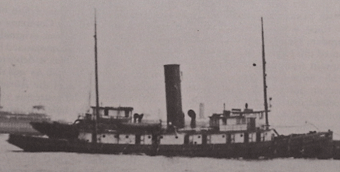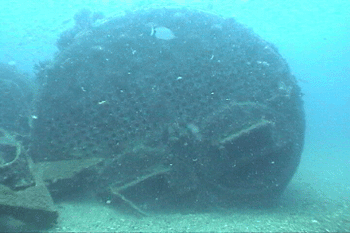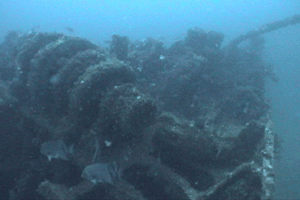SS Keshena
Sunk
July 19th, 1942
 The ocean going tug Keshena was built for
the Superior Transportation Company of Philadelphia, PA, in 1919 at Superior Wisconsin.
The tug had two steam boilers that provided power to drive the 142' long
tug's single propeller. The steel hull of the Keshena was designed in the
style of an older tug, with a fair and high bow, a low waist and the typical low
round stern of a tug. A small pilot house was perched on the forward
quarter of the deck house that covered the majority of her length with a
large single smokestack dominating her profile. She was equipped with
stout bits, winches and a large capstan on the foredeck. The tug also
carried spare salvage anchors on the foredeck, where they are still found today.
The ocean going tug Keshena was built for
the Superior Transportation Company of Philadelphia, PA, in 1919 at Superior Wisconsin.
The tug had two steam boilers that provided power to drive the 142' long
tug's single propeller. The steel hull of the Keshena was designed in the
style of an older tug, with a fair and high bow, a low waist and the typical low
round stern of a tug. A small pilot house was perched on the forward
quarter of the deck house that covered the majority of her length with a
large single smokestack dominating her profile. She was equipped with
stout bits, winches and a large capstan on the foredeck. The tug also
carried spare salvage anchors on the foredeck, where they are still found today.
In July of 1942, The Keshena found
herself being chartered to the U. S. Navy for coastal salvage work. She
had been called to the area off Hatteras Island to assist two tankers that had
become damaged. The two tankers, the M/V J. A. Mowinkel and the M/V
Chilore, had both been part of a convey of nineteen ships when they were
attacked by the U-576. Though stuck by torpedoes, both vessels were able to
continue under their own power toward more protected waters. A third
ship, the SS Bluefields, was not so fortunate and sunk within four
minutes after being hit by the U-boat. Unfortunately for the two surviving
Tankers, in their efforts to seek safety they inadvertently entered the Hatteras
minefield which had been set to provide relief from the attacking U-boats.
Both ships detonated mines and being further damaged, had to be left at anchor
to await assistance. The crew of M/V J. A. Mowinkel abandoned the
ship thinking that the U-boat had returned and would finish them off
shortly. They were able to safely land at Ocrakoke along with the crew
from the M/V Chilore.
Enter the salvage tug Keshena. She
was dispatched to assist the damaged tankers and arrived on the scene after
several mine sweepers sent down from Little Creek, Virginia, had cleared the
area around the damaged tankers of any further mines. However, when
the Keshena was maneuvering under the stern of the tanker J. A.
Mowinkel, an explosion occurred in the after part of the engine room.
It was very apparent that the mine sweeping operation was not fully
successful.
 John Hampton, the engine room oiler, was
killed by the blast. Another crewman, Fred Taylor, drowned while trying to
abandon the sinking Tug. The remaining 15 men of the crew were picked up
by a small launch and taken to Ocrakoke Coast Guard Station, arriving there at
1700 hours on the 19th.
John Hampton, the engine room oiler, was
killed by the blast. Another crewman, Fred Taylor, drowned while trying to
abandon the sinking Tug. The remaining 15 men of the crew were picked up
by a small launch and taken to Ocrakoke Coast Guard Station, arriving there at
1700 hours on the 19th.
After the sinking, Keshena's mast and
stack stood clear of the water marking her position. Like the F. W. Abrams
which lays nearby, this attracted the attention of pilots in training from
nearby Cherry Point Station who used her as practice bombing
target. She was also depth charged and dragged for clearance.
Tugs, due to their intended
use, are
typically designed as solid vessels and the Keshena is no
exception. The small vessel has endured the ravages of exploding
mines, practice bombing
runs, depth charging and over 50 years under the sea. That her
bow section
still stands almost 30' proud of the sand is testimony to both her
design and
her builder.
DiveHatteras Home
Send mail to webmaster@divehatteras.com with
questions or comments about this web site.
Copyright � 2003
Last modified: April 07, 2022
 John Hampton, the engine room oiler, was
killed by the blast. Another crewman, Fred Taylor, drowned while trying to
abandon the sinking Tug. The remaining 15 men of the crew were picked up
by a small launch and taken to Ocrakoke Coast Guard Station, arriving there at
1700 hours on the 19th.
John Hampton, the engine room oiler, was
killed by the blast. Another crewman, Fred Taylor, drowned while trying to
abandon the sinking Tug. The remaining 15 men of the crew were picked up
by a small launch and taken to Ocrakoke Coast Guard Station, arriving there at
1700 hours on the 19th. The ocean going tug Keshena was built for
the Superior Transportation Company of Philadelphia, PA, in 1919 at Superior Wisconsin.
The tug had two steam boilers that provided power to drive the 142' long
tug's single propeller. The steel hull of the Keshena was designed in the
style of an older tug, with a fair and high bow, a low waist and the typical low
round stern of a tug. A small pilot house was perched on the forward
quarter of the deck house that covered the majority of her length with a
large single smokestack dominating her profile. She was equipped with
stout bits, winches and a large capstan on the foredeck. The tug also
carried spare salvage anchors on the foredeck, where they are still found today.
The ocean going tug Keshena was built for
the Superior Transportation Company of Philadelphia, PA, in 1919 at Superior Wisconsin.
The tug had two steam boilers that provided power to drive the 142' long
tug's single propeller. The steel hull of the Keshena was designed in the
style of an older tug, with a fair and high bow, a low waist and the typical low
round stern of a tug. A small pilot house was perched on the forward
quarter of the deck house that covered the majority of her length with a
large single smokestack dominating her profile. She was equipped with
stout bits, winches and a large capstan on the foredeck. The tug also
carried spare salvage anchors on the foredeck, where they are still found today.



